
Alcea is a genus of over 80 species of flowering plants in the mallow family Malvaceae, commonly known as the hollyhocks. They are native to Asia and Europe. The single species of hollyhock from the Americas, the streambank wild hollyhock, belongs to a different genus.
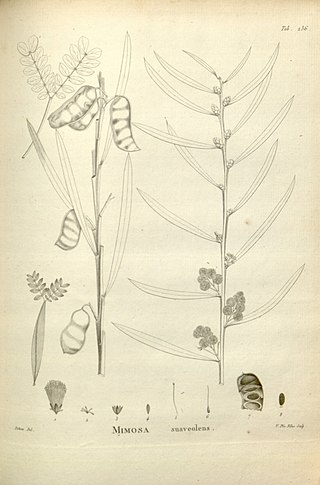
Phyllodes are modified petioles or leaf stems, which are leaf-like in appearance and function. In some plants, these become flattened and widened, while the leaf itself becomes reduced or vanishes altogether. Thus the phyllode comes to serve the purpose of the leaf. Some important examples are Euphorbia royleana which are cylindrical and Opuntia which are flattened.

Ruellia is a genus of flowering plants commonly known as ruellias or wild petunias. They are not closely related to petunias (Petunia) although both genera belong to the same euasterid clade. The genus was named in honor of Jean Ruelle (1474–1537), herbalist and physician to Francis I of France and translator of several works of Dioscorides.

Prunus × yedoensis is a hybrid cherry tree between Prunus speciosa as father plant and Prunus pendula f. ascendens as mother. It is a hybrid born in Japan and one of its cultivars, Prunus × yedoensis 'Somei-yoshino' or Yoshino cherry, is one of the most popular and widely planted cherry cultivars in temperate regions around the world today. 'Somei-yoshino' is a clone from a single tree, and has been propagated by grafting all over the world. 'Somei-yoshino' inherits Edo higan's quality of blooming before the leaves unfold and it growing into a large-sized tree. It also inherits the characteristics of the Oshima cherry, which grows rapidly and has white flowers. These characteristics are favored and have become one of the most popular cultivars of cherry trees.
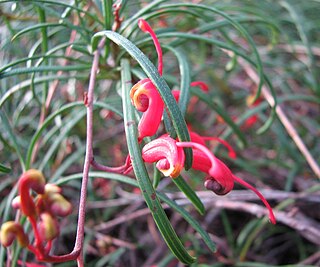
Grevillea nudiflora is a species of flowering plant in the family Proteaceae and is endemic to the south coast of Western Australia. It is a prostrate to low, spreading shrub, usually with linear leaves, and with small groups of red and yellow flowers often close to the ground on long flowering stems.

Ginoria nudiflora is a species of plant in the family Lythraceae. It is endemic to Mexico.
Ginoria is a genus of plants in the family Lythraceae.

Tetrameles is a genus of flowering plants in the family Tetramelaceae with one species, Tetrameles nudiflora. It grows as a large deciduous tree and is found across southern Asia from India through southeast Asia, Malesia, and into northern Australia.

Daviesia, commonly known as bitter-peas, is a genus of about 130 species of flowering plants in the family Fabaceae, and is endemic to Australia. Plants in the genus Daviesia are shrubs or small trees with leaves modified as phyllodes or reduced to scales. The flowers are arranged singly or in groups, usually in leaf axils, the sepals joined at the base with five teeth, the petals usually yellowish with reddish markings and the fruit a pod.

Callicarpa nudiflora is a species of beautyberry that is grown as an ornamental plant. It is native to Southeast Asia.

Proustia is a genus of flowering plants in the family Asteraceae, native to South America and the West Indies.
Acrocercops telestis is a moth of the family Gracillariidae. It is known from India (Bihar).
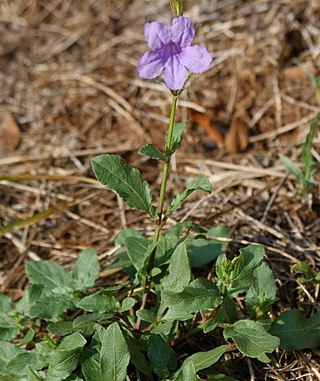
Ruellia nudiflora, the violet wild petunia, is a perennial plant in the acanthus family (Acanthaceae) found in areas of moisture in the Sonoran Desert. Despite its name, it is not a true petunia.

Prunus × nudiflora is a Korean native cherry tree originating from Jeju Island. It is a distinct species from Japanese native Yoshino cherry. King cherry is a rare plant and listed as an endangered species. As of April 2017, 194 king cherry trees were growing around Mt. Halla in Jeju Island. According to Gen-ichi Koidzumi, king cherry is erroneously believed to be discovered by a French missionary Émile Joseph Taquet although what he discovered was a different species.
Vernonanthura polyanthes is a species of Neotropical plant in the tribe Vernonieae.
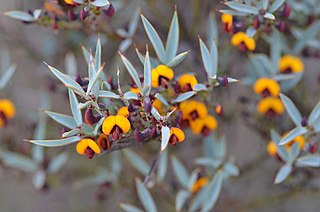
Daviesia nudiflora is a species of flowering plant in the family Fabaceae and is endemic to the south-west of Western Australia. It is a bushy shrub with sharply pointed, egg-shaped to elliptic or oblong phyllodes, and yellow-orange flowers with reddish-brown markings.
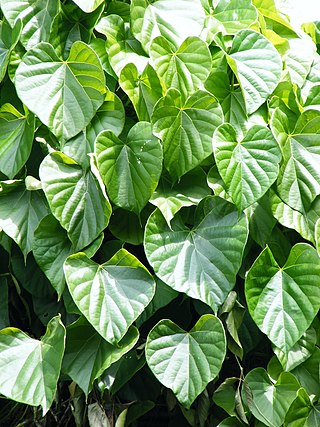
Tinospora is a genus of succulent woody climbing shrubs. Thirty-four species are currently recognized. Species generally send down long aerial roots from host trees. They have corky or papery bark. They are found in tropical and sub-tropical parts of Asia, Africa and Australia. The most common species are T. cordifolia and T. crispa.
Blackallia is a genus of flowering plants belonging to the family Rhamnaceae.
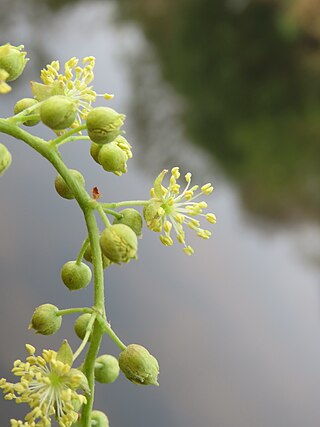
Mallotus nudiflorus, the false white teak, is a species of flowering plant in the family Euphorbiaceae. It is native to the Indian Subcontinent, southern China, Southeast Asia, western Indonesia, and the Philippines. It is a medium-sized tree, typically 10–20 m (33–66 ft) tall.
Sphaerolobium nudiflorum is a species of flowering plant in the family Fabaceae and is endemic to the south-west of Western Australia. It is a shrub that typically grows to a height of 15–60 cm (5.9–23.6 in) and has yellow or orange flowers from October to January. It was first formally described in 1844 by Carl Meissner who gave it the name Roea nudiflora in Lehmann's Plantae Preissianae. In 1864, George Bentham changed the name to Sphaerolobium nudiflorum in Flora Australiensis The specific epithet (nudiflorum) means "bare-flowered".















